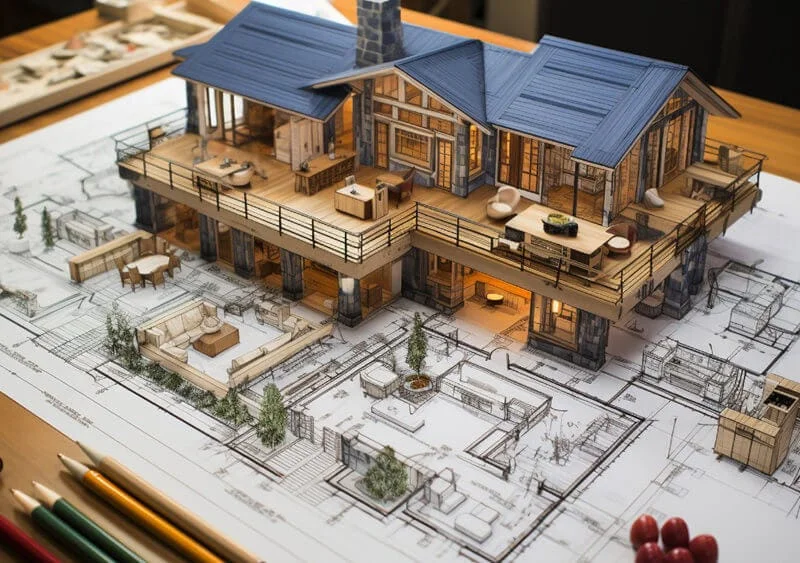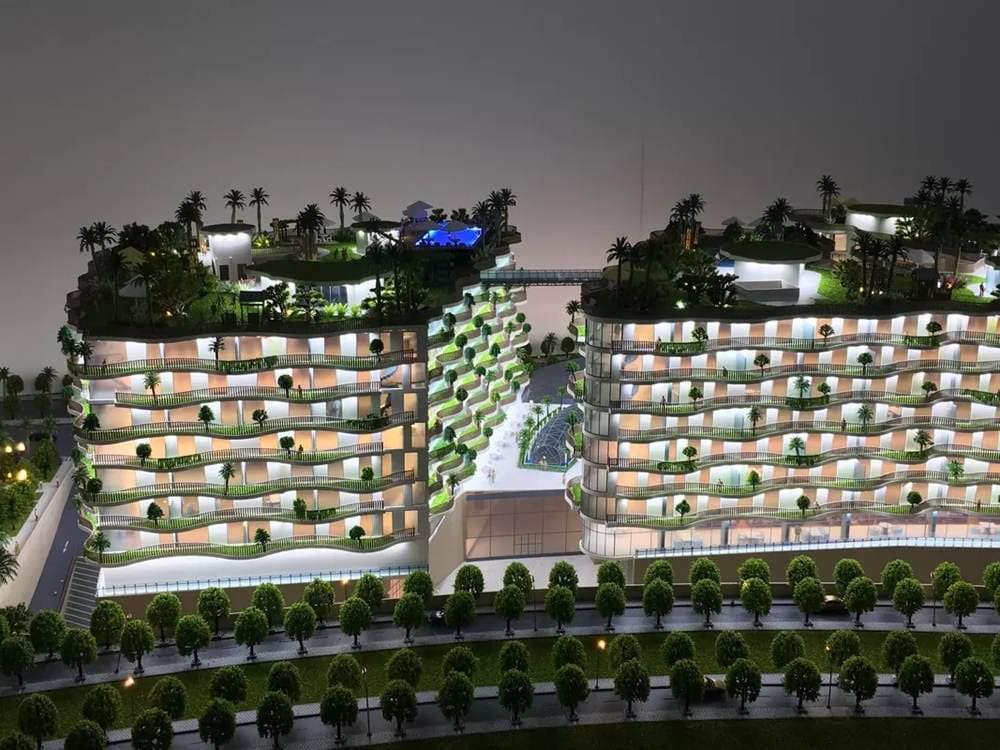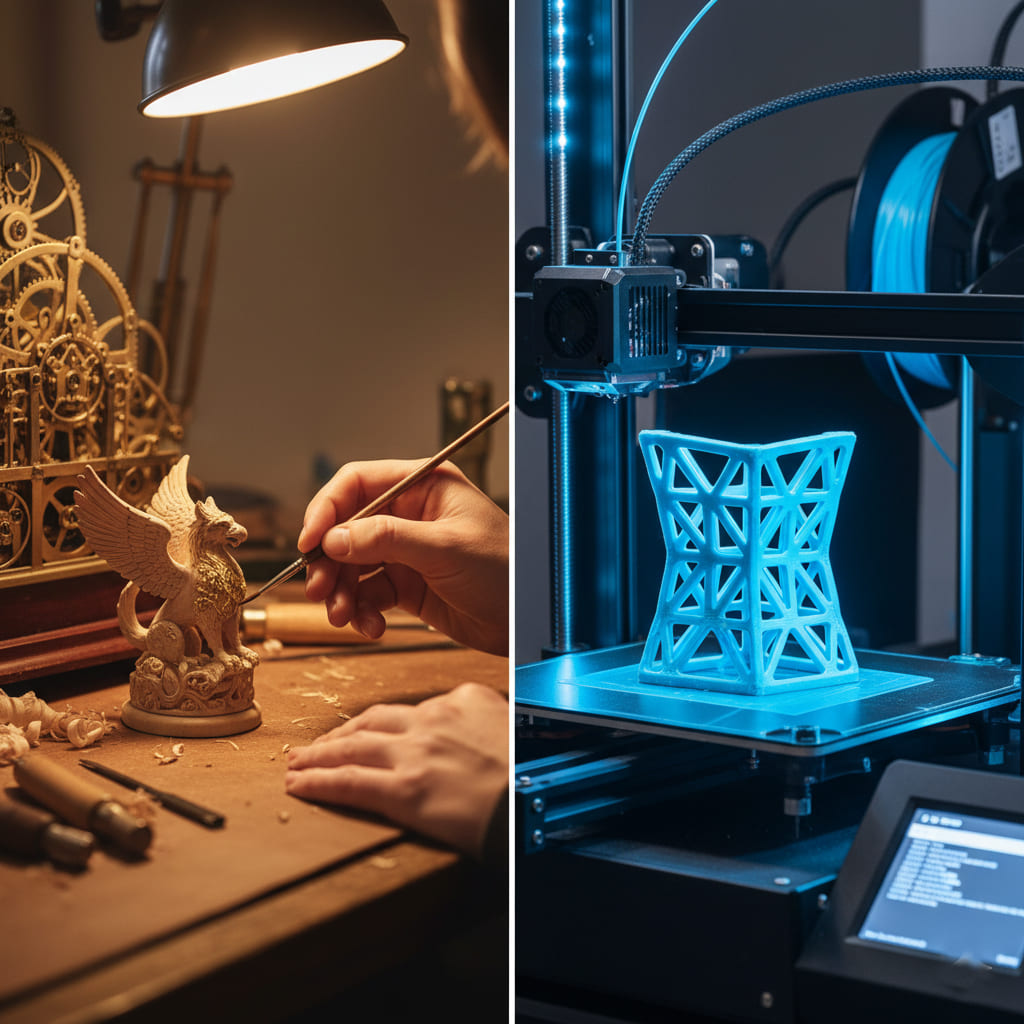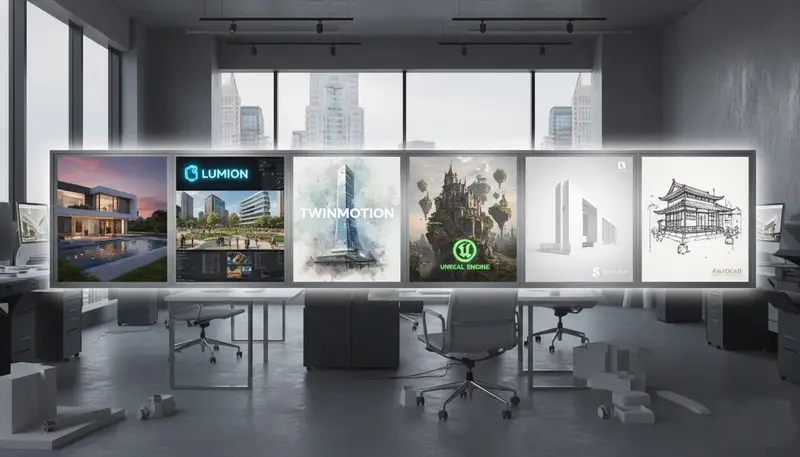Trong một thế giới ngày càng bị chi phối bởi công nghệ kỹ thuật số, nơi các thiết kế phức tạp có thể được tạo ra chỉ bằng vài cú nhấp chuột và khám phá thế giới ảo bằng tai nghe nhập vai, người ta có thể thắc mắc về số phận của truyền thống mô hình kiến trúc. Những thu nhỏ này, bản sao thủ công của các tòa nhà và cảnh quan đô thị đã là nền tảng của thực hành kiến trúc trong nhiều thế kỷ. Nhưng liệu chúng có còn giữ giá trị trong thời đại kết xuất quang học không?, Thực tế ảo (Vr), và mô hình hóa thông tin công trình (Bim)? câu trả lời, có lẽ đáng ngạc nhiên, là một câu trả lời đúng. Trong khi các công cụ của thương mại kiến trúc đã phát triển vượt bậc, các mô hình vật lý tiếp tục mang lại những lợi thế độc đáo mà các mô hình kỹ thuật số của chúng không thể sao chép hoàn toàn.
Từ những đường ziggurat của Lưỡng Hà cổ đại đến những thánh đường cao vút thời Phục hưng, các kiến trúc sư từ lâu đã dựa vào các mô hình để hình dung và truyền đạt ý tưởng của họ. Những thế giới thu nhỏ này, được làm từ gỗ, đất sét, và các vật liệu khác, cung cấp một liên kết hữu hình giữa trí tưởng tượng và thực tế. Họ cho phép các kiến trúc sư như Brunelleschi và Michelangelo thử nghiệm những thiết kế mang tính đột phá của mình, tinh chỉnh tỷ lệ và giải quyết các thách thức về cơ cấu trước khi cam kết xây dựng toàn diện. Hôm nay, các mô hình tiếp tục đóng vai trò là công cụ không thể thiếu, thu hẹp khoảng cách giữa lĩnh vực trừu tượng của các khái niệm thiết kế và thực tế cụ thể của môi trường xây dựng.
Mục lục
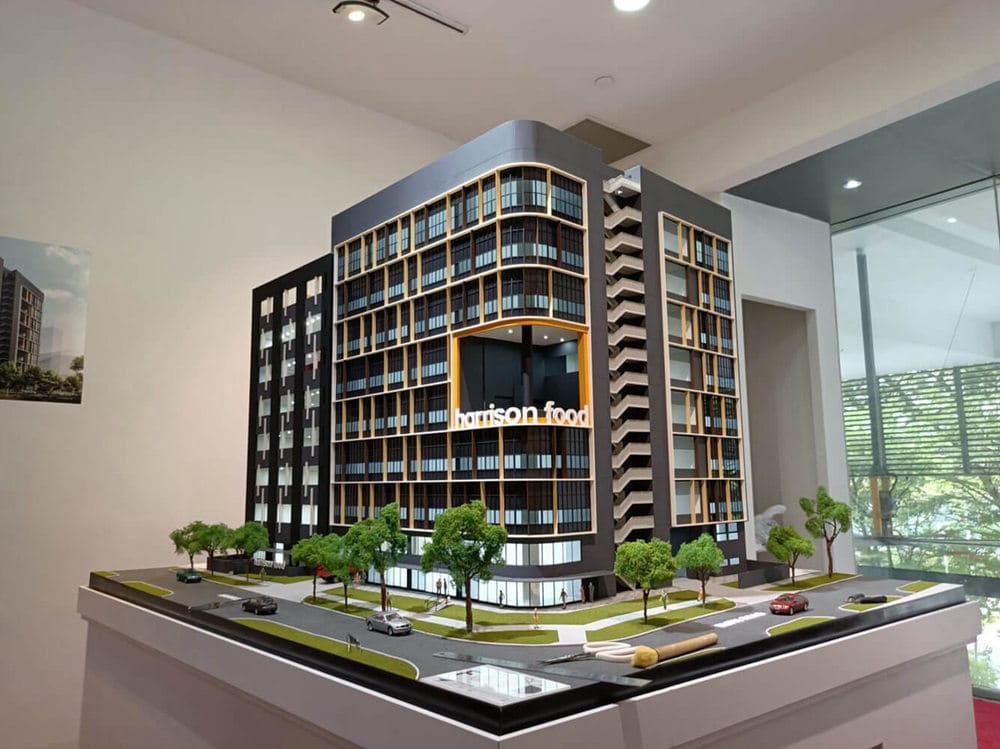
Tại sao các mô hình kiến trúc vẫn có liên quan?
Sự liên quan lâu dài của các mô hình kiến trúc bắt nguồn từ khả năng thu hút chúng ta ở nhiều cấp độ – về mặt trí tuệ., về mặt cảm xúc, và thể chất. Chúng cung cấp một loạt lợi ích độc đáo giúp nâng cao quá trình thiết kế, tạo điều kiện giao tiếp, và thúc đẩy sự đánh giá sâu sắc hơn về nghệ thuật và khoa học kiến trúc.
Hình dung phần chưa được xây dựng: Từ khái niệm đến hình thức hữu hình
- Phát triển thiết kế: Các mô hình cung cấp nền tảng hữu hình cho việc phát triển thiết kế. Chúng cho phép các kiến trúc sư thử nghiệm các hình thức khác nhau, cấu hình không gian, và bảng màu vật liệu. Cách tiếp cận thực hành này có thể tiết lộ những thách thức và cơ hội không lường trước được, dẫn đến các giải pháp thiết kế sáng tạo và thông tin hơn.
- Đại diện hữu hình: Không giống như kết xuất kỹ thuật số, chỉ tồn tại trên màn hình, các mô hình vật lý cung cấp một sự thể hiện hữu hình của một thiết kế. Tính hữu hình này làm cho việc nắm bắt quy mô dễ dàng hơn, hình thức, và các mối quan hệ không gian của một tòa nhà hoặc môi trường đô thị. Người ta có thể cầm một mô hình trong tay, xoay nó, và xem xét nó từ nhiều góc độ khác nhau, đạt được sự hiểu biết toàn diện mà khó có thể đạt được chỉ bằng các công cụ kỹ thuật số.
Tăng cường hiểu biết về không gian
- Dòng chảy thiết kế và mối quan hệ không gian: Mô hình giúp chúng ta hiểu được dòng chuyển động trong một tòa nhà, mối quan hệ giữa các không gian khác nhau, và tổ chức tổng thể của thiết kế. Chúng cho phép chúng tôi trải nghiệm thiết kế theo cách gần hơn với cách chúng tôi trải nghiệm tòa nhà thực tế.
- Ánh sáng tự nhiên và công thái học: Các mô hình vật lý có thể được sử dụng để nghiên cứu sự tương tác của ánh sáng tự nhiên trong không gian. Bằng cách đặt mô hình dưới các điều kiện ánh sáng khác nhau, kiến trúc sư có thể phân tích ánh sáng mặt trời sẽ xuyên qua tòa nhà như thế nào suốt cả ngày, ảnh hưởng đến bầu không khí và hiệu quả sử dụng năng lượng của thiết kế. Tương tự, các mô hình có thể được sử dụng để đánh giá các cân nhắc về ecgônômi, chẳng hạn như cách bố trí đồ nội thất và khả năng tiếp cận các khu vực khác nhau.
- Trải nghiệm xúc giác: Như Juhani Pallasmaa, một nhà lý luận kiến trúc nổi tiếng, nhấn mạnh, sự tham gia của chúng tôi với môi trường xây dựng không chỉ mang tính trực quan mà còn liên quan đến “trải nghiệm xúc giác” – cảm giác chạm và sự tương tác vật lý của chúng ta với vật liệu.
“Nhiệm vụ của kiến trúc là làm cho thế giới chạm vào chúng ta một cách hữu hình,”Các mô hình vật lý thu hút xúc giác của chúng ta, cho phép chúng ta cảm nhận được kết cấu của các vật liệu khác nhau và đánh giá cao trọng lượng cũng như độ chắc chắn của thiết kế.
Một ngôn ngữ phổ quát: Tạo điều kiện thuận lợi cho giao tiếp và hợp tác
- Giao tiếp khách hàng: Trình bày một mô hình vật lý cho khách hàng thường hiệu quả hơn nhiều so với việc cho họ xem một bộ bản vẽ hoặc bản trình bày kỹ thuật số.. Các mô hình cung cấp sự hiểu biết ngay lập tức và trực quan về thiết kế, cho phép khách hàng hình dung dự án và cung cấp phản hồi đầy đủ thông tin. Như một khách hàng đã nói một cách khéo léo,
“Có điều gì đó khi cầm một mô hình trên tay. Bạn không cần phải giải thích bất cứ điều gì. Bạn chỉ cần hiểu nó.”
- Đánh giá thiết kế: Mô hình là công cụ vô giá trong đánh giá thiết kế, cho phép các bên liên quan đánh giá dự án từ nhiều góc độ khác nhau và xác định sớm các vấn đề tiềm ẩn trong quá trình này. Họ cung cấp một tiêu điểm để thảo luận và tạo điều kiện cho những lời phê bình mang tính xây dựng.
- Tham vấn cộng đồng: Khi giới thiệu dự án tới công chúng, Đặc biệt là đối với sự phát triển đô thị quy mô lớn, mô hình vật lý có thể cực kỳ hiệu quả. Chúng cho phép mọi người hiểu được quy mô và tác động của dự án đối với môi trường của họ, thúc đẩy sự tham gia và đối thoại có ý nghĩa hơn. Ví dụ, toàn cảnh thành phố New York, được tạo ra cho 1964 Hội chợ thế giới, tiếp tục là nguồn tài liệu có giá trị cho các nhà quy hoạch đô thị và công chúng. Tương tự, Stadtmodell Berlin, Một 1:1000 đại diện quy mô của trung tâm Berlin, đóng vai trò quan trọng trong các quyết định quy hoạch đô thị.
- Hợp tác nhóm: Các mô hình tạo điều kiện cho sự hợp tác giữa các thành viên khác nhau của nhóm thiết kế và xây dựng. Kiến trúc sư, kỹ sư, và các nhà thầu có thể sử dụng mô hình này làm điểm tham chiếu chung, đảm bảo rằng mọi người đều ở trên cùng một trang và hướng tới một mục tiêu chung.
Thúc đẩy sự sáng tạo và đổi mới trong thiết kế
- Thử nghiệm và giải quyết vấn đề: Làm việc với các vật liệu vật lý khuyến khích thử nghiệm và giải quyết vấn đề bằng tay. Kiến trúc sư có thể thử nghiệm các hệ thống kết cấu khác nhau, khám phá sự kết hợp vật liệu, và tinh chỉnh các chi tiết theo cách thường trực quan và trực tiếp hơn là chỉ làm việc với các công cụ kỹ thuật số. Những nhân vật như Le Corbusier và Frank Lloyd Wright đã sử dụng các mô hình vật lý để kiểm tra tính táo bạo của họ., ý tưởng hiện đại. Đối với những kiến trúc sư này, người mẫu không thể thiếu trong quá trình sáng tạo của họ, đóng vai trò là công cụ để thử nghiệm và đổi mới.
- Giá trị của sự không hoàn hảo: Theo đuổi sự xuất sắc trong thiết kế, thậm chí “không hoàn hảo” các mô hình có thể cực kỳ có giá trị. Họ có thể bộc lộ những khuyết điểm, nêu bật các lĩnh vực cần cải thiện, và truyền cảm hứng cho những hướng đi mới có thể chưa được xem xét theo cách khác. Quá trình lặp đi lặp lại của việc xây dựng và hoàn thiện một mô hình là một hành trình khám phá, nơi những hiểu biết bất ngờ có thể xuất hiện ngay từ chính hành động sáng tạo.
Tác động của các công cụ kỹ thuật số đến sự thể hiện kiến trúc
Sự trỗi dậy của CAD, Bim, và kết xuất ảnh thực tế
| Tính năng | CAD | Bim | Kết xuất ảnh thực tế |
|---|---|---|---|
| Sự miêu tả | 2Phần mềm soạn thảo D và 3D thay thế soạn thảo thủ công. | Sự thể hiện kỹ thuật số về các đặc tính vật lý và chức năng của cơ sở, phục vụ như một nguồn tài nguyên kiến thức được chia sẻ. | Quá trình tạo hình ảnh quang học từ mô hình 2D hoặc 3D. |
| Những lợi ích | Tăng độ chính xác, sửa đổi dễ dàng hơn, lưu trữ và chia sẻ kỹ thuật số. | Cải thiện sự hợp tác, phát hiện xung đột, ước tính chi phí, quản lý vòng đời. | Tạo hình ảnh thực tế cao của thiết kế, nâng cao sự hiểu biết của khách hàng và tài liệu tiếp thị. |
| Sự va chạm | Đơn giản hóa quá trình soạn thảo, được phép cho hình học phức tạp hơn. | Cách mạng hóa việc điều phối dự án và quản lý thông tin, dẫn đến xây dựng hiệu quả và bền vững hơn. | Cải thiện khả năng truyền đạt giao diện của một thiết kế trước khi nó được xây dựng. |
| Ví dụ | Autocad, Bản phác thảo | Revit, ArchiCAD | V-Ray, Lumion, 3DS Max |
| Giới hạn | Chủ yếu tập trung vào biểu diễn hình học, thông tin hạn chế về hiệu suất xây dựng. | Yêu cầu đầu tư trả trước đáng kể vào phần mềm và đào tạo, có thể phức tạp để thực hiện cho các dự án nhỏ hơn. | Có thể tính toán chuyên sâu, có thể không truyền tải đầy đủ trải nghiệm không gian hoặc tính vật chất của thiết kế. |
| Quan hệ mẫu | Có thể được sử dụng để tạo các bản vẽ 2D từ đó xây dựng các mô hình vật lý. | Có thể được sử dụng để tạo các mô hình kỹ thuật số có thể in 3D thành mô hình vật lý, hoặc xem trong VR. | Có thể tạo kết xuất của cả mô hình kỹ thuật số và vật lý, hoặc được sử dụng để nâng cao khả năng trình bày của các mô hình vật lý bằng hình ảnh được chiếu. |
| Trị giá | Khác nhau tùy thuộc vào phần mềm, nhưng nhìn chung dễ tiếp cận hơn BIM đối với các công ty nhỏ hơn. | Thường cao hơn CAD do độ phức tạp của phần mềm và yêu cầu đào tạo. | Khác nhau tùy thuộc vào phần mềm và độ phức tạp của kết xuất, có thể đắt tiền cho chất lượng cao, hiển thị thời gian thực. |
- Tốc độ và hiệu quả: Các công cụ kỹ thuật số cho phép kiến trúc sư tạo và sửa đổi thiết kế với tốc độ và hiệu quả chưa từng có. Những thay đổi trước đây phải mất vài ngày hoặc vài tuần để thực hiện trong mô hình vật lý giờ đây có thể được thực hiện trong vài phút hoặc thậm chí vài giây.
- Độ chính xác và độ chính xác: Các mô hình kỹ thuật số cung cấp mức độ chính xác khó đạt được bằng các kỹ thuật tạo mô hình truyền thống. Độ chính xác này rất quan trọng để đảm bảo rằng tòa nhà cuối cùng được xây dựng như dự định.
- Sự hợp tác: Các công cụ kỹ thuật số đã thay đổi cách các kiến trúc sư cộng tác với đồng nghiệp, nhà tư vấn, và khách hàng trên toàn thế giới. Bim, đặc biệt, cho phép cộng tác theo thời gian thực trên một thiết bị duy nhất, mô hình chia sẻ, hợp lý hóa quá trình thiết kế và xây dựng.
Kinh nghiệm nhập vai: Thực tế ảo (Vr) và tăng cường thực tế (AR)
Công nghệ VR và AR đang đưa hình ảnh kiến trúc lên một tầm cao mới, mang đến những trải nghiệm sống động từng là lĩnh vực khoa học viễn tưởng.
- Hướng dẫn ảo: VR cho phép kiến trúc sư và khách hàng bước vào mô hình ảo của tòa nhà và trải nghiệm không gian như thể họ thực sự ở đó. Trải nghiệm sống động này mang lại cảm giác về quy mô tốt hơn nhiều, tỷ lệ, và bầu không khí hơn so với kết xuất truyền thống.
- Hiểu biết theo ngữ cảnh: AR phủ các mô hình kỹ thuật số lên môi trường thế giới thực, cho phép các kiến trúc sư và khách hàng thấy được tòa nhà được đề xuất sẽ phù hợp với môi trường xung quanh như thế nào. Công nghệ này đặc biệt hữu ích cho việc phân tích địa điểm và quy hoạch đô thị.
- Cộng tác từ xa: VR và AR cũng đang thay đổi cách các kiến trúc sư cộng tác với khách hàng và nhà tư vấn, những người có thể ở những nơi khác nhau trên thế giới. Những công nghệ này cho phép đánh giá thiết kế từ xa và truy cập trang web ảo, giảm nhu cầu đi lại và tạo điều kiện giao tiếp hiệu quả hơn.
Cặp song sinh kỹ thuật số: Mô phỏng hiệu suất tòa nhà
Bản song sinh kỹ thuật số là bản sao kỹ thuật số động của tài sản vật chất, chẳng hạn như các tòa nhà hoặc cơ sở hạ tầng. Chúng được tạo bằng dữ liệu từ cảm biến và các nguồn khác, cho phép giám sát và mô phỏng thời gian thực hiệu suất của tòa nhà.
- Phân tích dự đoán: Digital Twins có thể được sử dụng để dự đoán cách một tòa nhà sẽ phản ứng với các điều kiện khác nhau, chẳng hạn như những thay đổi về sức chứa, thời tiết, hoặc tiêu thụ năng lượng. Thông tin này có thể được sử dụng để tối ưu hóa hiệu suất của tòa nhà, giảm chi phí vận hành, và cải thiện sự thoải mái của người ngồi.
- Thiết kế bền vững: Digital Twins đóng vai trò ngày càng quan trọng trong thiết kế bền vững. Bằng cách mô phỏng hiệu suất năng lượng của một tòa nhà trước khi nó được xây dựng, kiến trúc sư có thể đưa ra quyết định sáng suốt về vật liệu, hệ thống, và thiết kế các chiến lược để giảm thiểu tác động môi trường.
- Quy hoạch đô thị: Bản song sinh kỹ thuật số cũng đang được sử dụng trong quy hoạch đô thị để lập mô hình toàn bộ thành phố và mô phỏng tác động của các dự án phát triển hoặc cơ sở hạ tầng mới. Điều này cho phép các nhà quy hoạch đưa ra quyết định sáng suốt hơn về việc sử dụng đất, vận tải, và quản lý tài nguyên.
Dân chủ hóa trực quan hóa thiết kế
Các công cụ kỹ thuật số đã giúp công chúng tham gia vào các dự án kiến trúc dễ dàng hơn thông qua mô phỏng và trực quan hóa tương tác.
- Sự tham gia của công chúng: Những công nghệ như “kính thiên văn” được sử dụng ở Pháp cho phép người dân hình dung các dự án đô thị bằng cách chuyển đổi giữa các góc nhìn khác nhau – thực tế hiện tại, tòa nhà có sẵn, và đề xuất phát triển. Điều này dân chủ hóa hình ảnh kiến trúc, làm cho nó dễ tiếp cận và tương tác hơn với công chúng.
- Thông tin phản hồi: Bằng cách cung cấp một cách trực quan và hấp dẫn hơn để trải nghiệm các dự án được đề xuất, các công cụ kỹ thuật số trao quyền cho công chúng để cung cấp phản hồi đầy đủ thông tin hơn và tham gia có ý nghĩa hơn vào quá trình thiết kế.

Vật lý vs. Điện tử: Một phân tích so sánh
Lợi ích hữu hình của mô hình vật lý
| Thuận lợi | Bất lợi |
|---|---|
|
|
Hiệu quả và tính linh hoạt của các mô hình kỹ thuật số
| Thuận lợi | Bất lợi |
|---|---|
|
|
Sự cùng tồn tại và tích hợp của các công cụ truyền thống và kỹ thuật số
Các mô hình vật lý và kỹ thuật số được sử dụng cùng nhau như thế nào?
- Điểm mạnh bổ sung: Các mô hình vật lý và kỹ thuật số không loại trừ lẫn nhau; chúng là những công cụ bổ sung có thể được sử dụng cùng nhau để nâng cao quá trình thiết kế.
- Quy trình làm việc lặp đi lặp lại: Kiến trúc sư thường bắt đầu với các mô hình vật lý để khám phá các khái niệm ban đầu và sau đó chuyển sang các mô hình kỹ thuật số để sàng lọc, Phân tích, và trình bày. Quy trình làm việc lặp đi lặp lại này cho phép khám phá bằng tay và thao tác kỹ thuật số chính xác.
Ví dụ về tích hợp mô hình-kỹ thuật số thành công
- 3D In mô hình vật lý từ thiết kế kỹ thuật số: Một trong những cách phổ biến nhất để tích hợp mô hình vật lý và kỹ thuật số là sử dụng in 3D để tạo mô hình vật lý từ thiết kế kỹ thuật số.. Điều này cho phép các kiến trúc sư nhanh chóng và dễ dàng tạo ra các nguyên mẫu vật lý cho thiết kế của họ, ngay cả những người có hình học phức tạp.
- Chiếu thông tin số lên các mô hình vật lý: Một kỹ thuật cải tiến khác là chiếu thông tin số, chẳng hạn như hoạt ảnh hoặc mô phỏng, trên các mô hình vật lý. Điều này có thể nâng cao khả năng trình bày của mô hình và mang lại trải nghiệm năng động và hấp dẫn hơn cho người xem.
- Sử dụng mô hình vật lý làm đầu vào cho mô phỏng kỹ thuật số: Các mô hình vật lý cũng có thể được sử dụng làm đầu vào cho mô phỏng kỹ thuật số. Ví dụ, mô hình vật lý của tòa nhà có thể được quét và nhập vào chương trình phần mềm để thực hiện kiểm tra đường hầm gió hoặc các loại phân tích khác.
- Nghiên cứu trường hợp: Nhiều công ty kiến trúc đã tích hợp thành công các kỹ thuật mô hình hóa vật lý và kỹ thuật số vào quy trình làm việc của họ. Các hãng này thường sử dụng kết hợp các mô hình thủ công, 3Mô hình in D, Kết xuất kỹ thuật số, và trải nghiệm VR để phát triển và truyền đạt thiết kế của họ.
Vai trò của kỹ thuật lai trong giáo dục kiến trúc
-
- Học tập toàn diện: Các trường kiến trúc trên khắp thế giới đang ngày càng kết hợp cả kỹ thuật mô hình vật lý và kỹ thuật số vào chương trình giảng dạy của họ. Điều này cung cấp cho sinh viên sự hiểu biết toàn diện về cả hai phương pháp tiếp cận và chuẩn bị cho họ về thực tế của thực hành kiến trúc đương đại..
- Áp dụng toàn cầu: Ví dụ từ các trường học ở Paris, Vương quốc Anh, và Trung Quốc chứng minh việc áp dụng toàn cầu các kỹ thuật lai, nhấn mạnh tầm quan trọng của việc cung cấp cho học sinh một nền giáo dục toàn diện, bao trùm cả truyền thống và đổi mới.
Các loại và cách sử dụng khác nhau của mô hình kiến trúc
Mô hình kiến trúc có nhiều dạng khác nhau, mỗi cái được điều chỉnh cho phù hợp với mục đích và giai đoạn cụ thể của quá trình thiết kế.
Mô hình khái niệm hoặc đại chúng
- Mục đích: Được sử dụng trong giai đoạn đầu của thiết kế để nhanh chóng thử nghiệm ý tưởng, khám phá các mối quan hệ không gian, và đánh giá các phương án tạo khối khác nhau.
- Đặc trưng: Đơn giản, các biểu diễn trừu tượng tập trung vào hình thức và khối lượng tổng thể, thường được làm từ những vật liệu rẻ tiền như bìa cứng hoặc xốp.
- Những lợi ích: Cho phép khám phá nhanh chóng các phương án thiết kế và tạo điều kiện thuận lợi cho các cuộc thảo luận sớm giữa nhóm thiết kế.
Mô hình làm việc hoặc học tập
- Mục đích: Được sử dụng để tinh chỉnh thiết kế, phân tích chi tiết kết cấu, kiểm tra kỹ thuật thi công, và giải quyết các vấn đề thiết kế cụ thể.
- Đặc trưng: Chi tiết hơn các mô hình khối, thường kết hợp các yếu tố thiết kế và vật liệu cụ thể.
- Những lợi ích: Tạo điều kiện hiểu biết sâu sắc hơn về thiết kế và giúp xác định những thách thức xây dựng tiềm ẩn.
Mô hình thuyết trình
- Mục đích: Được sử dụng để truyền đạt thiết kế cuối cùng cho khách hàng, Các bên liên quan, và công chúng.
- Đặc trưng: Rất chi tiết và thực tế, thường bao gồm cả cảnh quan, ánh sáng, và các tính năng khác để tăng cường sự hấp dẫn trực quan.
- Những lợi ích: Cung cấp sự trình bày hấp dẫn và thuyết phục về thiết kế, giúp đảm bảo sự chấp thuận và tạo hứng thú cho dự án.
Mô hình chi tiết
- Mục đích: Tập trung vào các yếu tố thiết kế cụ thể, chẳng hạn như mặt tiền, đồ mộc, hoặc không gian nội thất.
- Đặc trưng: Các mô hình quy mô lớn cho phép kiểm tra chặt chẽ vật liệu, kết cấu, và chi tiết xây dựng.
- Những lợi ích: Giúp cải tiến thiết kế ở mức độ chi tiết và đảm bảo rằng sản phẩm cuối cùng đáp ứng các tiêu chuẩn về thẩm mỹ và chức năng mong muốn.
Mô hình đô thị hoặc địa điểm
- Mục đích: Được sử dụng để hình dung sự phát triển đô thị quy mô lớn, dự án cơ sở hạ tầng, hoặc mối quan hệ giữa một tòa nhà và bối cảnh xung quanh nó.
- Đặc trưng: Thể hiện diện tích lớn hơn so với mô hình tòa nhà, thường kết hợp địa hình, cảnh quan, và các tòa nhà xung quanh.
- Những lợi ích: Tạo thuận lợi cho việc lập kế hoạch, tham vấn cộng đồng, và đánh giá tác động môi trường.
Mô hình nội thất
- Mục đích: Chú trọng thiết kế không gian nội thất, bao gồm cả đồ nội thất, kết thúc, và ánh sáng.
- Đặc trưng: Trình bày chi tiết về môi trường bên trong, thường ở quy mô lớn hơn các mô hình xây dựng.
- Những lợi ích: Giúp khách hàng hình dung được thiết kế nội thất và đưa ra quyết định sáng suốt về vật liệu, màu sắc, và đồ đạc.
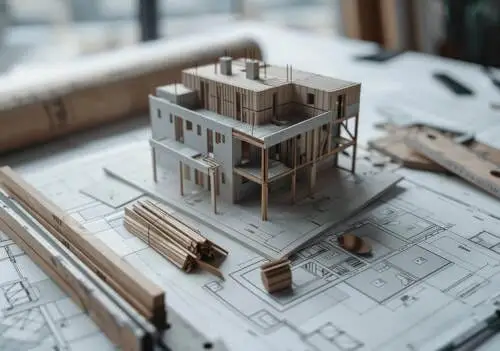
Những vật liệu và công cụ nào được sử dụng để tạo ra các mô hình kiến trúc?
Vật liệu truyền thống và tính chất của chúng
| Vật liệu | Sự miêu tả | Thuận lợi | Bất lợi | Sử dụng chung |
|---|---|---|---|---|
| Tấm bìa cứng | Vật liệu làm từ giấy được làm từ các lớp bột giấy. | Rẻ tiền, Nhẹ, dễ dàng cắt và tạo hình. | Không bền lắm, dễ bị hư hại do độ ẩm. | Mô hình khái niệm, nghiên cứu đại chúng, mô hình tạm thời. |
| Bảng bọt | Vật liệu nhẹ bao gồm lõi xốp polystyrene được kẹp giữa các lớp giấy hoặc nhựa. | Nhẹ, dễ dàng cắt và tạo hình, tương đối rẻ, cung cấp một bề mặt mịn. | Có thể dễ dàng bị móp hoặc hư hỏng, không bền như các vật liệu khác. | Mô hình khối lượng, mô hình nghiên cứu, Mô hình trình bày. |
| Gỗ | Một vật liệu tự nhiên có thể cắt được, chạm khắc, và được tạo thành nhiều hình dạng khác nhau. (Balsa, gỗ trầm thường được sử dụng) | Mạnh, bền, có thể được chà nhám và sơn để đạt được nhiều kiểu hoàn thiện khác nhau, mang tính thẩm mỹ. | Có thể đắt hơn các vật liệu khác, đòi hỏi nhiều kỹ năng hơn để làm việc với. | Mô hình trình bày, mô hình chi tiết, mô hình đòi hỏi trình độ tay nghề cao. |
| Nhựa | Một vật liệu tổng hợp có thể đúc được, ép đùn, hoặc đúc thành nhiều hình dạng khác nhau. (Styrene, acrylic là phổ biến) | Bền, chống nước, có thể trong suốt hoặc mờ đục, có sẵn trong nhiều màu sắc và kết cấu. | Có thể khó cắt và tạo hình hơn các vật liệu khác, có thể yêu cầu chất kết dính chuyên dụng. | Mô hình trình bày, mô hình chi tiết, mô hình yêu cầu độ trong suốt hoặc bề mặt hoàn thiện cụ thể. |
| Đất sét | Một cách tự nhiên, vật liệu đất có thể được đúc và tạo hình khi ướt và cứng lại bằng cách sấy khô hoặc nung. | Dễ dàng tạo khuôn, có thể được sử dụng để tạo ra các hình dạng và kết cấu hữu cơ, rẻ tiền. | Có thể dễ vỡ khi khô, đòi hỏi kỹ năng làm việc với. | Mô hình khái niệm, mô hình nghiên cứu, chi tiết điêu khắc. |
| Kim loại | Một người mạnh mẽ, vật liệu bền có thể cắt được, uốn cong, và hàn thành nhiều dạng khác nhau. | Cực kỳ bền, có thể được sử dụng để tạo ra các chi tiết phức tạp, mang tính thẩm mỹ. | Có thể đắt tiền, đòi hỏi các công cụ và kỹ năng chuyên dụng để làm việc với. | Mô hình chi tiết, các yếu tố cấu trúc, mô hình đòi hỏi độ chính xác và độ bền cao. |
Các công cụ cần thiết để làm mô hình
- Công cụ cắt:
- Dao thủ công: Được sử dụng để cắt chính xác các vật liệu khác nhau.
- Dao mổ: Được sử dụng để cắt rất tốt và chi tiết.
- Kéo: Dùng để cắt giấy, bìa cứng mỏng, và các vật liệu khác.
- Thảm cắt: Thảm tự phục hồi bảo vệ bề mặt làm việc và tạo nền tảng ổn định để cắt.
- Công cụ đo lường:
- Thước kẻ: Dùng để đo và đánh dấu đường thẳng.
- Đặt hình vuông: Dùng để vẽ và đo góc vuông.
- La bàn: Dùng để vẽ hình tròn và hình cung.
- thước đo góc: Dùng để đo và vẽ góc.
- Chất kết dính:
- Keo PVA: Chất kết dính gốc nước thích hợp để dán giấy, Tấm bìa cứng, và gỗ.
- keo siêu dính: Chất kết dính khô nhanh, thích hợp để dán nhiều loại vật liệu, bao gồm cả nhựa và kim loại.
- Xịt keo: Dùng để dán các bề mặt lớn, chẳng hạn như gắn giấy hoặc vải vào tấm lót.
- Băng: Băng keo hai mặt, băng che, và các loại băng khác có thể được sử dụng để liên kết tạm thời hoặc vĩnh viễn.
- Công cụ hoàn thiện:
- Giấy nhám: Dùng để làm phẳng và tạo hình bề mặt.
- Tệp: Được sử dụng để tạo hình và tinh chỉnh các cạnh.
- Sơn: Được sử dụng để thêm màu sắc và chi tiết cho mô hình.
- Bàn chải: Dùng để sơn và dán keo.
Sự trỗi dậy của chế tạo kỹ thuật số: 3D In và Phay CNC
Công nghệ chế tạo kỹ thuật số, chẳng hạn như in 3D và phay CNC, đang chuyển đổi lĩnh vực chế tạo mô hình, cung cấp các cấp độ tốc độ mới, Độ chính xác, và sự phức tạp.
- 3D in:
- Quá trình: 3D in, còn được gọi là sản xuất phụ gia, là một quá trình tạo ra các vật thể ba chiều bằng cách lắng đọng các lớp vật liệu liên tiếp, thường là nhựa, nhựa, hoặc kim loại, dựa trên mô hình kỹ thuật số.
- Thuận lợi:
- Tốc độ: 3In D có thể tạo ra các mô hình nhanh hơn nhiều so với các phương pháp thủ công truyền thống, đặc biệt đối với các hình dạng phức tạp.
- Độ chính xác: 3Máy in D có thể tạo ra các mô hình có độ chính xác cao và chi tiết, với các tính năng khó hoặc không thể đạt được bằng tay.
- Sự phức tạp: 3In D cho phép tạo ra các hình học phức tạp và phức tạp mà việc sản xuất bằng các phương pháp truyền thống sẽ gặp khó khăn.
- Tùy chỉnh: 3In D cho phép tạo ra các mô hình tùy chỉnh và độc đáo phù hợp với yêu cầu thiết kế cụ thể.
- Nguyên vật liệu: Nhiều loại vật liệu có thể được sử dụng trong in 3D, bao gồm các loại nhựa (PLA, Abs, PETG), nhựa, nylon, và thậm chí cả kim loại.
- Phay CNC:
- Quá trình: CNC (Điều khiển số máy tính) phay là một quy trình sản xuất trừ sử dụng dụng cụ cắt quay để loại bỏ vật liệu khỏi khối vật liệu rắn, chẳng hạn như gỗ, nhựa, hoặc kim loại, dựa trên mô hình kỹ thuật số.
- Thuận lợi:
- Độ chính xác: Phay CNC có thể tạo ra các bộ phận có độ chính xác cao và chính xác với dung sai chặt chẽ.
- Tính linh hoạt của vật liệu: Phay CNC có thể được sử dụng với nhiều loại vật liệu, bao gồm cả gỗ, nhựa, kim loại, và vật liệu tổng hợp.
- Sức mạnh và độ bền: Các bộ phận được phay CNC thường chắc chắn hơn và bền hơn các bộ phận được in 3D, vì chúng được làm từ những khối vật liệu rắn.
- Nguyên vật liệu: Phay CNC có thể được sử dụng với nhiều loại vật liệu, bao gồm cả gỗ, nhựa (acrylic, PVC), Kim loại (nhôm, thau), và vật liệu tổng hợp.
Liệu các mô hình kiến trúc vật lý có còn phù hợp trong tương lai không??
Tương lai của các mô hình kiến trúc nằm ở sự tích hợp liên tục của công nghệ vật lý và kỹ thuật số, tạo ra một cảnh quan năng động và phát triển cho việc thể hiện thiết kế.
Giá trị lâu dài của tính hữu hình trong thế giới kỹ thuật số
Bất chấp những tiến bộ trong công nghệ kỹ thuật số, nhu cầu cơ bản của con người về trải nghiệm hữu hình sẽ đảm bảo rằng các mô hình vật lý vẫn phù hợp trong tương lai.
- Kết nối cảm xúc: Các mô hình vật lý gợi lên cảm giác ngạc nhiên và thích thú mà khó có thể tái tạo bằng các biểu diễn kỹ thuật số. Họ tạo ra một kết nối cảm xúc với thiết kế vượt qua giới hạn trí tuệ thuần túy.
- Hiểu biết trực quan: Khả năng chạm, giữ, và kiểm tra một mô hình vật lý cung cấp sự hiểu biết trực quan về quy mô, hình thức, và các mối quan hệ không gian mà các công cụ kỹ thuật số không thể so sánh được.
Tác động của các công nghệ mới nổi
Công nghệ mới nổi, chẳng hạn như VR, AR, và thực tế hỗn hợp (ÔNG), sẵn sàng nâng cao hơn nữa vai trò của các mô hình vật lý, tạo ra những khả năng mới cho sự tương tác và trực quan hóa.
- Trải nghiệm lai: Hãy tưởng tượng một tương lai nơi các mô hình vật lý được tăng cường bằng thông tin kỹ thuật số được chiếu lên bề mặt của chúng, hoặc nơi lớp phủ VR và AR cung cấp trải nghiệm tương tác hòa trộn giữa thế giới vật lý và kỹ thuật số.
- Mô hình tương tác: Các mô hình có thể kết hợp các cảm biến và bộ truyền động phản hồi khi chạm hoặc các hình thức tương tác khác, tạo ra những trải nghiệm năng động và hấp dẫn. Ví dụ, chạm vào một phần cụ thể của mô hình có thể kích hoạt hoạt ảnh kỹ thuật số hoặc hiển thị thông tin liên quan trên màn hình gần đó.
Tính bền vững và dấu chân môi trường của các mô hình
Khi nhận thức về các vấn đề môi trường ngày càng tăng, tính bền vững của hoạt động tạo mô hình sẽ ngày càng trở nên quan trọng.
- Vật liệu thân thiện với môi trường: Các kiến trúc sư và nhà sản xuất mô hình đang khám phá việc sử dụng các vật liệu bền vững và tái chế, chẳng hạn như tre, nút chai, và nhựa sinh học. Các công ty như Phòng thí nghiệm tre Và làm bằng không khí đang đi tiên phong trong việc sử dụng các cải tiến, vật liệu thân thiện với môi trường.
- Thực hành kỹ thuật số có trách nhiệm: Việc giải quyết tác động môi trường của công nghệ kỹ thuật số cũng rất quan trọng, bao gồm mức tiêu thụ năng lượng của trung tâm dữ liệu và chất thải điện tử do phần cứng bị loại bỏ. Các sáng kiến như Trung tâm dữ liệu xanh đang nỗ lực thúc đẩy các hoạt động bền vững trong ngành công nghệ.
Vai trò tiếp tục trong giáo dục, Giao tiếp, và Khám phá sáng tạo
Các mô hình vật lý sẽ tiếp tục đóng một vai trò quan trọng trong giáo dục kiến trúc, giao tiếp khách hàng, sự tham gia của công chúng, và quá trình thiết kế sáng tạo.
- Giáo dục kiến trúc: Các mô hình mang lại trải nghiệm học tập thực hành vô giá cho học sinh, giúp các em phát triển kỹ năng suy luận không gian và hiểu biết về các nguyên tắc xây dựng. Chúng cho phép học sinh học bằng cách làm, thúc đẩy sự hiểu biết sâu sắc hơn về các khái niệm thiết kế.
- Giao tiếp khách hàng: Chúng vẫn là một công cụ mạnh mẽ để truyền đạt ý tưởng thiết kế tới khách hàng, tăng cường sự hiểu biết và xây dựng sự đồng thuận. Bản chất xúc giác của các mô hình cho phép khách hàng kết nối với thiết kế ở cấp độ cá nhân hơn.
- Sự tham gia của công chúng: Các mô hình vật lý có thể thu hút công chúng theo cách mà các mô hình kỹ thuật số thường không thể làm được, biến chúng thành những công cụ thiết yếu cho việc tham vấn và triển lãm cộng đồng. Chúng cung cấp một sự trình bày hữu hình về một dự án mà mọi người có thể liên quan và hiểu được..
- Khám phá sáng tạo: Hành động xây dựng mô hình là một quá trình sáng tạo có thể khơi dậy những ý tưởng mới, tiết lộ giải pháp bất ngờ, và làm sâu sắc thêm mối liên hệ của kiến trúc sư với thiết kế của họ. Đó là một dạng phác thảo ba chiều cho phép khám phá các khả năng thiết kế một cách trực quan và trôi chảy hơn.
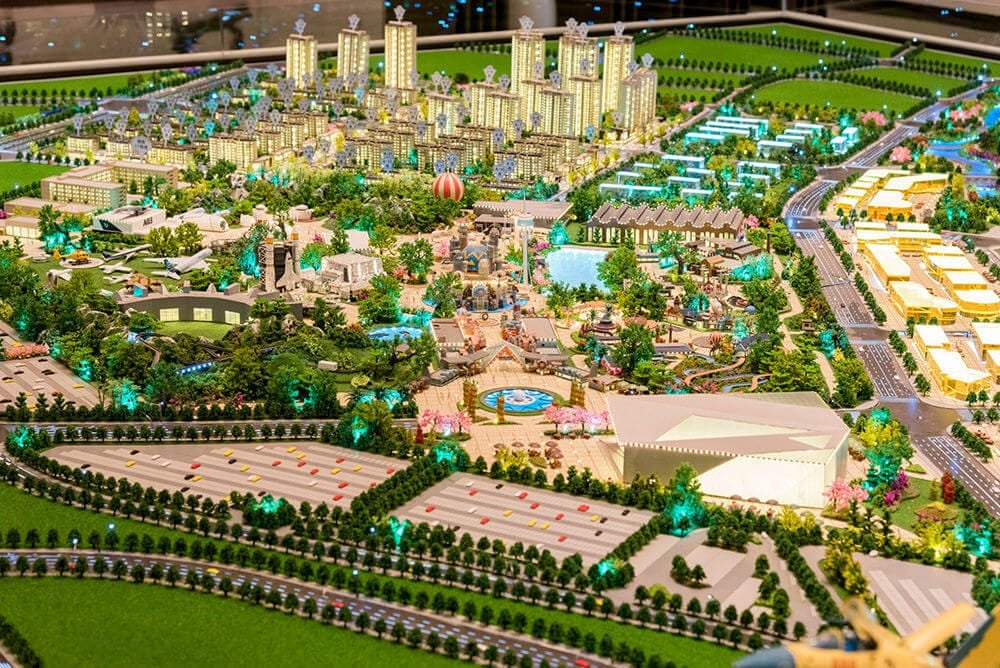
Phần kết luận
Tóm lại, tầm quan trọng lâu dài của các mô hình kiến trúc trong thời đại kỹ thuật số là không thể phủ nhận. Trong khi các công cụ kỹ thuật số chắc chắn đã cách mạng hóa nghề kiến trúc, các mô hình vật lý vẫn giữ được sức mạnh độc đáo của họ để truyền cảm hứng, thông báo, và kết nối chúng ta với môi trường được xây dựng. Chúng cung cấp một giá trị hữu hình, trải nghiệm xúc giác bổ sung và nâng cao khả năng của công nghệ kỹ thuật số. Khi chúng ta tiến về phía trước, tương lai của sự thể hiện kiến trúc có thể sẽ liên quan đến sự tích hợp chặt chẽ hơn nữa của các phương pháp tiếp cận vật lý và kỹ thuật số, tạo ra một cảnh quan năng động và thú vị cho việc khám phá và giao tiếp thiết kế. Nghệ thuật làm mô hình, không còn là di tích của quá khứ, đang phát triển và thích nghi, đảm bảo rằng các mô hình vật lý sẽ tiếp tục định hình theo cách chúng ta tưởng tượng, thiết kế, và trải nghiệm thế giới xung quanh chúng ta cho các thế hệ mai sau.
“Bàn tay, phối hợp với tâm trí, vẫn là một công cụ mạnh mẽ để sáng tạo và hiểu biết.” Tình cảm này, mặc dù không phải là lời trích dẫn trực tiếp từ một kiến trúc sư nổi tiếng, gói gọn giá trị lâu dài của việc tạo mô hình vật lý trong kiến trúc.
Theo lời của kiến trúc sư và nhà giáo dục, Nhà máy Beth, từ Squire & Đối tác:
“Những công nghệ mới này là công cụ bổ sung trong vành đai của bạn, Chúng tôi rất hiếm khi tạo ra toàn bộ mô hình được in 3D. Chúng tôi sử dụng máy in để biết chi tiết nơi chúng có thể tăng tốc mọi thứ, những phần lặp đi lặp lại mà chúng ta không còn phải mất nhiều thời gian để cắt mọi thứ bằng dao mổ. Nó cho phép bạn có nhiều thời gian hơn để khám phá các khía cạnh sáng tạo hơn của một kế hoạch hoặc một sản phẩm. Sự thay đổi công nghệ này sẽ làm tăng tính sáng tạo, thay vì giảm bớt nó, vì vậy đó là một điều khá tích cực. Tôi nghĩ người tạo mô hình là những người giải quyết vấn đề thực tế, nhưng mọi thứ chúng tôi làm sẽ luôn được đặt làm riêng.”
Quan điểm của cô nhấn mạnh vai trò ngày càng tăng của các nhà sản xuất mô hình, những người không bị thay thế bởi công nghệ mà đang thích nghi với nó, sử dụng các công cụ mới để nâng cao kỹ năng của họ và khám phá những con đường sáng tạo mới.
| Diện mạo | Quá khứ | Hiện tại | Tương lai |
|---|---|---|---|
| Nguyên vật liệu | Chủ yếu là gỗ, Tấm bìa cứng, đất sét, bọt. | Vật liệu truyền thống bên cạnh nhựa, 3Vật liệu in ấn D (PLA, Abs, nhựa), vật liệu tổng hợp. | Tăng cường sử dụng vật liệu bền vững và tái chế (cây tre , nhựa sinh học), vật liệu thông minh đáp ứng với kích thích. |
| Công cụ | Dụng cụ cầm tay, dao thủ công, cưa, keo dán. | Dụng cụ cầm tay, dụng cụ điện, 3D Máy in, bộ định tuyến CNC, Máy cắt laser, phần mềm thiết kế kỹ thuật số. | Tích hợp với VR/AR để tạo mô hình tương tác, Các công cụ thiết kế và chế tạo được hỗ trợ bởi AI. |
| Mục đích | Thăm dò thiết kế, Bài thuyết trình của khách hàng, hướng dẫn thi công. | Phát triển thiết kế, hình dung, giao tiếp, sự hợp tác, mô phỏng, sự tham gia của công chúng. | Khám phá thiết kế nâng cao với phản hồi thời gian thực, trải nghiệm khách hàng sâu sắc, màn hình công cộng tương tác, tích hợp với công nghệ tòa nhà thông minh. |
| Vai trò của công nghệ | Hạn chế sử dụng công nghệ, chủ yếu là các quy trình thủ công. | Tích hợp các công cụ thiết kế và chế tạo kỹ thuật số, sử dụng VR/AR để trực quan hóa. | Tích hợp liền mạch giữa vật lý và kỹ thuật số, với các mô hình trở thành môi trường tương tác và đáp ứng. |
| Tác động môi trường | Phụ thuộc vào vật liệu sử dụng, tiềm năng lãng phí. | Nâng cao nhận thức về tính bền vững, sử dụng vật liệu tái chế, mà còn cả mức tiêu thụ năng lượng của các công cụ kỹ thuật số. | Tập trung vào các nguyên tắc kinh tế tuần hoàn, sử dụng vật liệu sinh học, giảm thiểu chất thải và tiêu thụ năng lượng. |
Cho dù bạn là một kiến trúc sư, một sinh viên, hoặc đơn giản là ai đó bị mê hoặc bởi môi trường xây dựng, dành thời gian để đánh giá cao tính nghệ thuật và sự khéo léo của các mô hình kiến trúc. Tham quan triển lãm, khám phá tài nguyên trực tuyến, và thậm chí có thể thử tự mình làm mô hình. Bằng cách nắm lấy cả hữu hình và kỹ thuật số, chúng ta có thể hiểu sâu hơn và đánh giá cao sức mạnh của thiết kế trong việc định hình thế giới của chúng ta.
Bạn nghĩ gì về tương lai của các mô hình kiến trúc? Chia sẻ ý kiến của bạn dưới đây!


